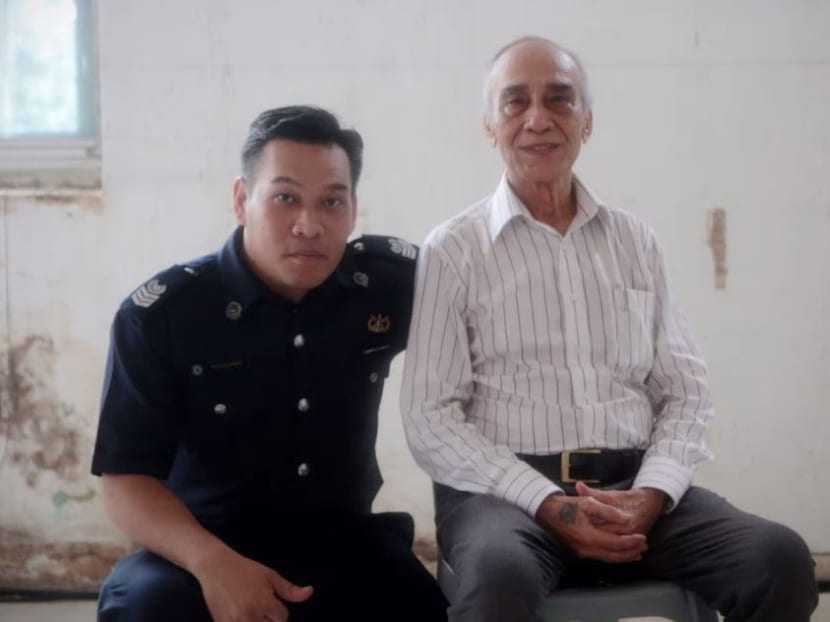Heritage exhibit to pay tribute to former Traffic Police HQ
SINGAPORE — There was a time when, if you were a candidate taking a test in driving school and you made a mistake that means immediate failure, you would hear your instructor shout “jiak perng lo” (Hokkien for “time to eat”), which is the lingo used to signal that the test was over.

Mr David Jermias Pattiselanno (right), who joined the Mobile Squad in 1956, and his son, Mr Ian Marks Pattiselanno, who is now assistant service quality officer with the Traffic Police. Pattiselanno Snr recalled that the Squad used to line up their bikes for inspection beside the former Red Dot Traffic building, and officers who failed the inspection would have to patrol on foot that day. Photo: Jason Quah/TODAY
SINGAPORE — There was a time when, if you were a candidate taking a test in driving school and you made a mistake that means immediate failure, you would hear your instructor shout “jiak perng lo” (Hokkien for “time to eat”), which is the lingo used to signal that the test was over.
There was also a time when learner drivers with lower academic background would use a toy car on a map for the theory portion of their driving test, to show and tell how they would react in certain road situations. They would fail immediately, for example, if they lifted the toy car off the map “because cars cannot fly”.
These anecdotes and more are being curated for a permanent heritage exhibit to be opened to the public at the former Red Dot Traffic building along Maxwell Road. The building has gone through several transformations over the decades: It was originally the Traffic Police headquarters and home to Singapore’s first driving test centre.
In the latest change announced by the Ministry of Law in January, it will undergo renovation and become an extension of the integrated dispute resolution complex that is Maxwell Chambers, located next to it. An overhead bridge will be built to connect the two buildings.
The most obvious change would be to its exterior, as it sheds its iconic red facade and takes on a shade of white, which is closer to its original look in the 1930s. The facelift will also allow it to house around 50 new offices across four floors for international dispute resolution institutions, arbitration chambers, law firms and ancillary legal services.
Speaking to some 50 active and retired Traffic Police officers who gathered to recall their experiences and memories on Monday (May 15), Senior Minister of State (Law and Finance) Indranee Rajah said: “28 Maxwell Road is not just brick and mortar, and certainly much more than the colour of its walls … More important than its architectural features are your stories and memories of the place, accumulated over the years.”
Six Singapore University of Technology and Design students were tasked in February to gather their recollections. They have interviewed 12 Traffic Police officers so far, and some of their stories have been shared on the Facebook page and Instagram account called “Humans of 28 Maxwell Road”.
It includes the account of former driving coach Lew Sin Kee, 76, who remembered a drain at the edge of the road near the building. It used to be left uncovered, he said, so that it would be easy to tell when candidates failed their parallel-parking test — the wheels of the test-car would naturally roll into the drain.
There was also a contribution by 79-year-old David Jermias Pattiselanno, who joined the Mobile Squad in 1956, when Singapore was still a British colony.
He recalled that the Squad used to line up their bikes for inspection at what is now an open-air car park beside the building, and officers who failed the inspection would have to patrol on foot that day.
The students also found out that, in the past, Traffic Police officers manning the summons booth had to work from behind cage-like wire frames, to protect them from gangsters who would hurl foul substances at them.
Giving an update on the Law Ministry’s plans to preserve the building’s heritage, Ms Indranee said that a new 24-hour thoroughfare would cut through the width of the building, so that pedestrians may walk between Tanjong Pagar MRT Station and the future Maxwell MRT Station, slated to be ready by 2021 under the planned Thomas-East Coast Line.
As for the building itself, awnings and roofs added to it in the past 10 years will be removed to restore its courtyards to the original open-to-sky design. This is so that when renovations are completed by 2019, those who visit there may “chill out” at its five courtyards, Ms Indranee said.
Refurbishing works will kick off in the second half of the year, led by award-winning homegrown architect Mok Wei Wei.








